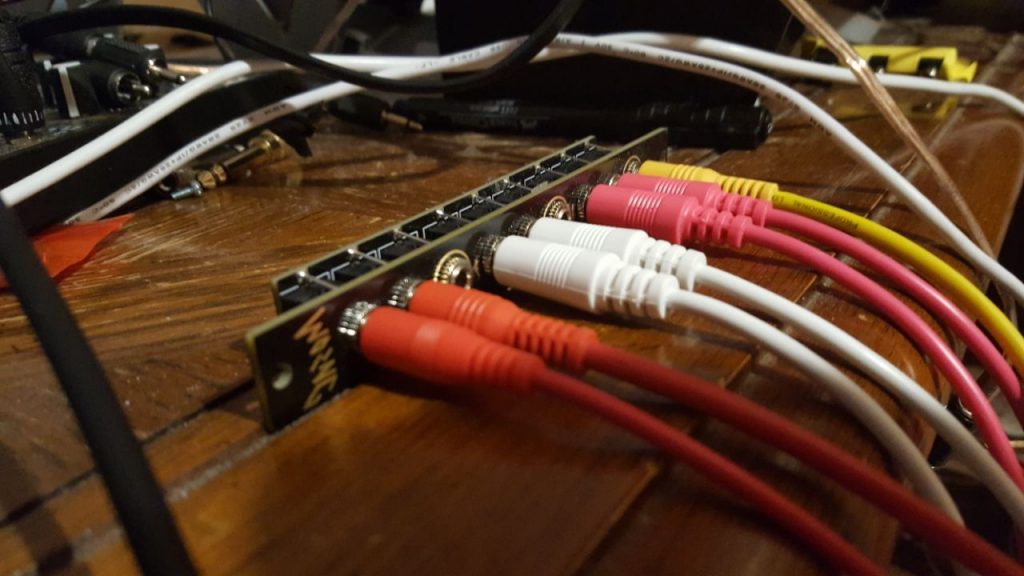- What kind of thing is it? The Turing Machine is a clock-driven stepped random voltage and trigger generator. Clock-driven means you have to hit it with a pip of voltage to make it do something, and stepped means that the voltage output switches instantly from one voltage to the next instead of transitioning gradually. You can also set the randomness to zero and use the write switch to turn it into a binary step sequencer. The Pulses expander is a cascading trigger source which uses the Turing Machine’s voltages to send out triggers, and the Voltages expander uses that same set of voltages to create a stepped random voltage output which is truly analogue instead of quantised to eight bits like the Turing Machine’s main out. There’s also a random noise generator which is always going.
https://www.instagram.com/p/BcACYfglPcS/?taken-by=quollism
- How is it useful? Random voltages can be used as the basis for the pitches of notes, a non-repeating modulation source, etc. The randomness can be controlled either by using the big friendly dial and by a control voltage. If you feed it an audio-rate clock source like a pulsewave from an oscillator, it can act as a randomising waveshaper, or you can use it as a graphic oscillator with the Voltages expander. Random triggers meanwhile can be used to set off drums or other instruments. It also looks very impressive with all its blinky lights.
- How does it work? Inside the Turing Machine is a shift register. A register’s job is to accept and maintain values (in this case, ons and offs), and a shift register can shift those values when commanded, kind of like they’re on a conveyor belt. Every time the module is triggered, the values all move along one spot BUT there’s a certain probability (set by dial or CV) that the outermost value of the register could change from on to off (or from off to on). The Turing Machine’s shift register’s state then feeds into a digital-to-analogue converter where it’s turned into an 8-bit voltage, and out it comes.
https://www.instagram.com/p/BcNOCYQl1zU/?taken-by=quollism
So is it analogue or digital? Both. The Turing Machine is analogue in the sense that it doesn’t have a fixed sample rate, but digital in the sense that its workings are driven by discrete values (on/off) and the output is an 8-bit voltage (one of 256 possibilities). If by “digital” you mean “it has a CPU”, it’s analogue. But if by “analogue” you mean “it doesn’t contain a DAC and the output voltage isn’t stepped in any way”, it’s digital. The Voltages expander sends each step through a slide potentiometer which makes it a bit more analogue than the main Turing Machine module.
- Whose YouTube demo convinced you to buy it? Mylar Melodies made a strong case, but Divkid’s demo sold me when he ran it at audio rate at around 22:25 – that was my breaking point. 🙂
- Does it work well? For sure. Being able to control randomness with CV is super good fun when the module is clocked at audio rates, although if it doesn’t have a 50% duty cycle at high audio rates it sometimes doesn’t clock properly. It’s possible to switch the randomness off entirely and use it as a binary sequencer with careful use of the write switch. The Turing Machine’s Noise output is handy but needs amplifying to be useful.
- Are you still using it? Absolutely. The Turing Machine is one of those go-to modules that epitomises Eurorack’s cool factor for me – it has blinky lights and does many useful things with tech that’s been around for ages (in this case, 4000-series CMOS chips). Not for nothing does it show up in so many racks.
- It’s a kit – how easy was it to build? The main module was easy, although this was the 23rd Eurorack module kit I’d built and that includes far more complicated builds like the Befaco Rampage and the Hexinverter Mutant Clap. The Pulses Mk II expander has SMD components which I’m still getting used to working with, so that was the more memorably difficult build! And the Voltages Mk II was easy-peasy, as promised.
- Surprises/disappointments? I researched this one pretty well so there hasn’t been anything too surprising or disappointing aside from the quiet noise out.
- Who makes it (and where?): Music Thing Modular, kits sold by Thonk out of the United Kingdom.
- Stats: Turing Maching Mk II is 10HP, Pulses Mk II is 4HP, Voltages Mk II is 12HP again.
ModularGrid: Turing Machine, Pulses, Voltages (all Mk II)






